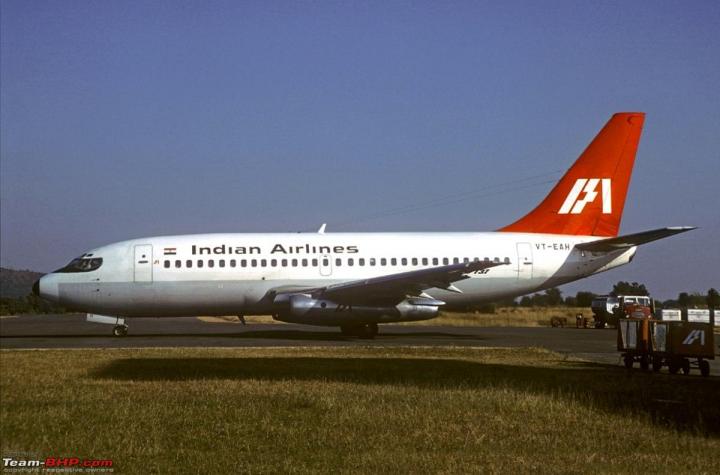News
Aviation expert list 8 hull losses of Indian Airlines Boeing 737
Aviation in India is safer than in many countries, but, facilities and equipment in many of the smaller airfields still leave much to be desired.
BHPian TKMCE recently shared this with other enthusiasts.
A recent Facebook post on the arrival of the first Boeing 737 of Indian Airlines in 1970 is the trigger for this post. The Boeing 737 was a workhorse for the airline. It owned 30 of them at various stages in the period 1970-2000 and briefly leased another 6 during the late 1980s. The dozen or so Boeing 737s still in service were transferred in the late 1990s to Alliance Air.
However the service record of the Boeing 737s with Indian Airlines was not great. Of the 30 aircraft it owned, as many as 8 were "hull losses" - aircraft damaged beyond repair or destroyed. This included one aircraft which was destroyed in an accident after it was transferred to Alliance Air.
Now 8 aircraft written off out of 30 is not a small number. To keep it in perspective, out of the 49 Airbus A320s the airline operated at various times till its merger with Air India, there was only one hull loss.
I work in aviation but in commercial. However I have followed aviation safety issues from my teenage days and track aircraft accidents and incidents. A little research on these 8 hull losses brought out the fact that as many as 6 were due to pilot error. One was attributed to an equipment malfunction and the last one was due to an explosion while on flight.
I will be listing out the 8 hull losses in chronological order with the description of the accident as given in the Aviation Safety Network website, a leading source of accident data.
1) 31 May 1973 at Delhi
Registration: VT-EAM
Narrative: The Boeing 737 named "Saranga" collided with high tension wires during an NDB instrument approach, crashed and caught fire. The visibility was below minima, but the pilot continued the approach, descended below minimum descent altitude and selected 40deg. flaps without sighting the runway.
2) 17 December 1978 at Hyderabad
Registration: VT- EAL
Narrative: The Indian Airlines aircraft lifted off from runway 09, but the leading edge devices did not deploy and as a result the aircraft became aerodynamically unstable. The takeoff was aborted and the aircraft was flared for a belly landing with undercarriage retracted. The aircraft belly-landed in nose up, left wing low attitude, on the centre line of the runway. It slid for 3080 feet, hit a boundary fence, crossed a drain and ploughed in rough terrain negotiating with small boulders and came to rest. Fire broke out on impact. The aircraft was completely destroyed by fire. Three persons cutting grass near the boundary fence of the airport were killed.
Probable cause: Non-availability of leading edge devices immediately after rotation during take-off.
3) 26 April 1979 at Chennai
Registration: VT-ECR
Narrative: On its way from Trivandrum to Madras, the aircraft was cleared to descent from FL270. Shortly afterwards an explosion took place in the forward lavatory, causing a complete instrument and electrical failure.
The Boeing had to make a flapless landing at Madras (now Chennai). The aircraft touched down 2500 feet past the runway 25 threshold and overran. The right side of the plane caught fire.
Probable cause: "Detonation of an explosive device in the forward lavatory of the aircraft. The aircraft overshot the runway due to high speed of touchdown, non-availability of reverse thrust and anti-skid system due to systems failure consequent on explosion."
4) 19 October 1988 at Ahmedabad
Registration: VT-EAH
Narrative: The Boeing 737-2A8 was operating Indian Airlines flight 113 from Bombay (now known as Mumbai) to Ahmedabad, India. At 06:41 hours, while the aircraft was descending to FL55, the flight was instructed to report over the Ahmedabad VOR. Visibility was reported being 2000m in haze with calm winds and a QNH of 1010 mb. The flight crew reported overhead the VOR and prepared for a localizer-DME approach to runway 23. Last radio contact with the flight was at 06:50. It struck trees and a high-tension pylon before crashing into a paddy field, bursting into flames.
Probable cause: "Error on the part of pilot-in-command as well as co-pilot due to non adherence to laid down procedures under poor visibility conditions."
5) 16 August 1991 at Imphal
Registration: VT-EFL
Narrative: Indian Airlines flight 257 departed Calcutta at 11:54 on a scheduled 60-minute flight to Imphal, India.
The crew contacted Imphal at 12:34. The flight was cleared to descent to from FL290 to 10,000 feet and asked to report overhead the VOR for ILS runway 04.
At 12:39 the crew reported 12 miles inbound at 10,000 feet. The pilot then asked the air traffic controller as to whether they could set course directly outbound for let down. This was approved. Two minutes later the flight reported approaching overhead the VOR, although it was still 14 miles out. The controller then queried: "understand you are proceeding on a radial 217 for ILS". This was confirmed by the crew.
At 12:42 Imphal ATC cleared the flight to proceed outbound for an ILS approach to runway 04 descending to 5,000 feet. At 12:44 the flight reported commencing the procedure turn. This was the last contact with the flight.
The airplane impacted Thangjing Hill, in inclement weather conditions with low clouds and occasional rain.
Probable cause: "The accident occurred by reason of a grave error on the part of the Pilot-in-Command in not adhering to the operational flight plan and ILS let down chart and not realizing that his early descent to 10,000 feet and turning right for outbound leg without reporting overhead VOR would result in loss of time reference and as such misplace him in the hilly terrain. The Pilot-in-Command's action may have been influenced by his extreme familiarity with the terrain".
6) 26 April 1993 at Aurangabad
Registration: VT-ECQ
Narrative: Boeing 737 VT-ECQ was operating flight 491 from Delhi to Bombay with enroute stops at Jaipur, Udaipur and Aurangabad. The heavily laden aircraft started its takeoff roll from Aurangabad's runway 09 (which is approx 7500 feet long) in high temperatures (38-41deg C). After lifting off almost at the end of the runway, it impacted heavily with a lorry carrying pressed cotton bales on a highway at a distance of about 410 feet from the end of runway. The left main landing gear, left engine bottom cowling and thrust reverser impacted the left side of the truck at a height of nearly seven feet from the level of the road. Thereafter the aircraft hit the high tension electric wires nearly 3 km North-East of the runway and hit the ground.
Probable cause: "(i) Pilots' error in initiating late rotation and following wrong rotation technique, and (ii) failure of the NAA to regulate the mobile traffic on the Beed road during the flight hours".
7) 2 December 1995 at Delhi
Registration: VT-ECS
Narrative: Indian Airlines Boeing 737 aircraft VT-ECS was operating flight IC-492 from Mumbai (Bombay) to Delhi via Jaipur. Following an unstabilized approach, the plane touched down some 2000 feet before the end of the runway. The aircraft could not be stopped on the remaining runway length and went beyond the runway into kutcha ground. Both engines, undercarriage and the wings sustained major damage.
Probable cause: "The accident was caused by the combined effect of (a) The injudicious and imprudent decision of the Pilot-in-Command to hastily complete the flight in the inadequate time available before the notified closure of Delhi airport for a VVIP flight, (b) The dangerously unstabilised approach made by the Pilot-in-Command, primarily due to his failure to decelerate the aircraft in time, (c) The failure of the First Officer to call out significant deviations from the stipulated approach parameters, (d) The failure of the Pilot-in-Command to carry out a missed approach in spite of his approach being grossly unstabilised, (e) The inadvertent omission of the Pilot-in-Command to arm the speed brake before landing, (f) Touch-down of the aircraft at excessive speed and too far down the runway, (g) Failure of the First Officer and Pilot-in-Command to monitor the automatic deployment of the speed brake, and failure of the Pilot-in-Command to deploy it manually, (h) Impact of the aircraft with an 18-inch high cement-concrete cable duct in the kutcha ground beyond the over-run area".
And finally, the Alliance Air 737 accident at Patna. The aircraft was earlier operated by Indian Airlines.
8) 17 July 2000 at Patna
Registration: VT-EGD (Alliance Air)
Narrative: Flight 7412 departed Calcutta 21 minutes late, at 06:51, for a flight to Patna, Lucknow and Delhi. The crew had been cleared to land at runway 25 when they requested a 360-degree orbit because they were high on the approach. Permission was granted and a left turn was initiated. During the left turn, the aircraft stalled. The plane then grazed a few single-storied houses in a government residential housing estate at Aneeshabad and exploded into a ball of fire. The aircraft broke into four pieces. The accident site is located about 2 km southwest of the Patna Airport.
Weather reported at 07:30 included temperature 30deg C (86 F), dewpoint 27deg C (80 F); 997 mB; wind calm, haze, 4000 m visibility. The aircraft in question, VT-EGD, had been involved in an accident 14 years ago. On January 15, 1986, the pilot of flight 529 attempted to land at Tiruchirapalli in conditions below weather minima. During a go-around the wing contacted the runway due to an excessive bank angle. The wing was substantially damaged, but there were no injuries among the 6 crew and 122 passengers.
Probable cause: "The cause of the accident was the loss of control of the aircraft due to Human Error (air crew). The crew had not followed the correct approach procedure, which resulted in the aircraft being high on approach. They had kept the engines at idle thrust and allowed the airspeed to reduce to a lower than normally permissible value on approach. They then maneuvered the aircraft with high pitch attitude and executed rapid roll reversals. This resulted in the actuation of the stick shaker stall warning indicating an approaching stall. At this stage, the crew initiated a Go Around procedure instead of Approach to Stall Recovery procedure resulting in an actual stall of the aircraft, loss of control and subsequent impact with the ground."
Of the above accidents, the full investigation reports of the ones at Aurangabad, Imphal and Patna are available in the public domain at the DGCA website although in the case of the first two , they were uploaded only a few years back. The Aurangabad one was particularly shocking. There was negligence everywhere including by the ground staff and the full report points it out.
In conclusion, have we learned from these accidents? Aviation in India is safer than in many countries but facilities and equipment in many of the smaller airfields still leave much to be desired. Also many of the recommendations of the enquiry committees are not actioned on time. After the first Air India Express accident at Mangalore, the enquiry had come down heavily on the organizational culture in the airline, yet 10 years down the line nothing much had happened by the time the second accident happened at Calicut. And with Indian aviation growing by leaps and outbounds, we cannot afford to be lethargic.
Check out BHPian comments for more insights and information.



















